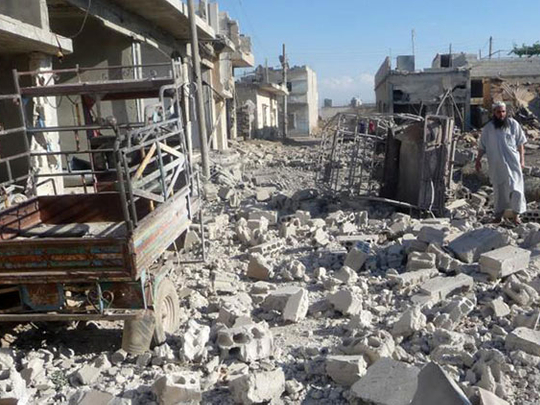
BEIRUT - Heavy fighting raged around the strategic Syrian border town of Qusayr and the capital Damascus on Monday and further reports surfaced of chemical weapons attacks by President Bashar Al Assad’s forces on rebel areas. The Syrian military pounded eastern suburbs of Damascus with air strikes and artillery and loud explosions echoed around Al Nabak, 80 km (50 miles) north of the capital, where fighting has cut the highway running north to the central city of Homs, the pro-opposition Syrian Observatory for Human Rights group said. Syrian government offensives in recent weeks are widely seen as a campaign to strengthen Al Assad’s negotiating position before a proposed international peace conference sponsored by the United States and Russia. Opposition activists said Syrian troops backed by Lebanese Hezbollah fighters were pressing a sustained assault on Qusayr, a town long used by insurgents as a way station for arms and other supplies from Lebanon. For Al Assad, Qusayr is a crucial link between Damascus and loyalist strongholds on the Mediterranean coast. Recapturing the town, in central Homs province, could also sever connections between rebel-held areas in the north and south of Syria. In Harasta, an eastern Damascus suburb largely under rebel control, dozens of people were suffering the effects of an apparent overnight chemical attack, according to opposition sources. Video showed victims lying on the floor of a large room, breathing from oxygen masks. The sides in the conflict, now in its third year, have accused each other of using chemical weapons. France’s Le Monde newspaper published first-hand accounts on Monday of apparent chemical attacks by Al Assad’s forces in April. The newspaper said one of its photographers had suffered blurred vision and respiratory difficulties for four days after an attack on April 13 on the Jobar front, in central Damascus. Another video from Harasta overnight showed at least two fighters being put into a van, their eyes watering and struggling to breathe while medics put tubes into their throats. It was not possible to verify the videos independently, given the difficulties of media access in Syria.
A doctor interviewed in another video said the alleged chemical attack in Harasta was revenge for a rebel raid on nearby military checkpoints. He complained of a severe shortage in staff and medical supplies to treat “dozens of wounded”.
Syria, which is not a member of the anti-chemical weapons convention, is believed to have one of the world’s last remaining stockpiles of undeclared chemical arms. US Secretary of State John Kerry and Russian Foreign Minister Sergio Lavrov were meanwhile meeting in Paris to discuss efforts for a peace conference to bring an end to the conflict in Syria. The U.S.-Russian initiative provides the first slim hope in almost a year for a diplomatic end to a conflict that has cost more than 90,000 lives and caused a refugee exodus that the U.N. refugee agency expects to top 3.5 million by the end of 2013.
China, which along with Russia, has three times blocked U.N. Security Council action on Syria, said on Monday it would join the proposed peace conference. A Foreign Ministry spokesman said it would make efforts with all concerned to “push for an early, just, peaceful and appropriate settlement of the Syrian issue”.
Damascus has indicated it will take part in the talks, but the fractured opposition, which has previously required Al Assad’s exit to be guaranteed before any negotiations, has yet to lay out its position and remains mired in internal quarrels.












